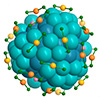| Apr 09, 2025 |
Researchers precisely removed a gold nanoparticle’s core atom and outermost electron to study how magnetic spin affects its catalytic activity.
(Nanowerk News) A team of researchers from the Hefei Institutes of Physical Science of the Chinese Academy of Sciences (CAS) has consecutively removed the innermost atom and the outermost electron of a gold nanoparticle—without disturbing its overall structure. This precise manipulation allowed them to probe how the magnetic spin of the material influences its catalytic activity.
|
|
The work, led by Prof. WU Zhikun in collaboration with Prof. YANG from the Institute of Process Engineering, CAS and Prof. TANG from Chongqing University, was published in Science Advances (“Remove the innermost atom of a magnetic multi-shell gold nanoparticle for near-unity conversion of CO2 to CO”).
|
|
Gold nanoclusters—tiny particles composed of from a few to hundreds of gold atoms—are ideal models for studying how atomic structure affects material properties. But tuning the structure of such clusters atom by atom, especially when they’re relatively large and complex, has long been a major challenge.
|
|
To overcome this problem, the team developed a novel synthesis method using a mixture of thiol and iodine ligands to stabilize a multi-shelled gold cluster: [Au127I4(TBBT)48], where TBBT is a bulky sulfur-containing molecule. Then, by introducing additional thiols, they were able to gently “pluck out” the single gold atom at the very center of the structure—like removing a pea from the middle of a nesting doll—without collapsing the surrounding shells. This created a new, stable cluster: Au126I4(TBBT)48, which is diamagnetic.
|
|
What’s more, by carefully oxidizing this structure, the researchers created a third version: [Au126I4(TBBT)48]+, which regained paramagnetism. In effect, the team demonstrated the ability to precisely alter the material’s magnetic state by consecutively removing one atom and one electron—a level of control rarely achieved in nanomaterials.
|
|
Using this series of clusters, the researchers were able to study how the distribution of magnetic spin changed across the structure. They found that spin density shifted outward as the central atom was removed and the particle was oxidized. Even more interestingly, the spins tended to concentrate more on the iodine atoms than on the sulfur atoms, indicating that the spin could play an important role in tuning the catalytic properties.
|
|
To test this idea, the team evaluated how well each version of the gold nanocluster could catalyze the reduction of carbon dioxide to carbon monoxide—a reaction of growing interest in clean energy research. The diamagnetic version (Au126I4) achieved nearly 100% Faradaic efficiency at a relatively low voltage, outperforming its paramagnetic counterparts. This result strongly supports the idea that magnetic spin plays a significant role in catalysis.
|
|
“Our findings provide important insights into how spin influence catalytic behavior,” said Prof. WU. “This could open up new strategies for designing multifunctional materials at the atomic level.”
|

